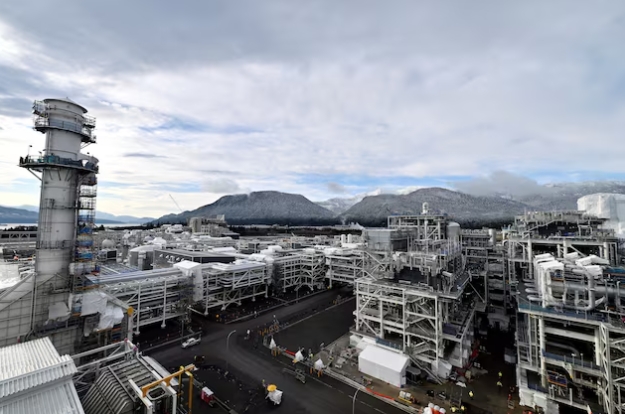
A general view of LNG Canada's liquified natural gas facility in Kitimat, British Columbia, Canada November 19, 2024.
Located on Canada’s Pacific Coast, LNG Canada is North America’s first major LNG facility with direct access to the Pacific. The project, a joint venture involving Shell Plc, Petronas, PetroChina, Mitsubishi Corp, and Kogas, represents a significant investment of approximately CDN$40 billion (US$29.4 billion), making it the largest private-sector investment in Canadian history. When fully operational, the facility will have the capacity to export 14 million metric tonnes of LNG annually.
“This is something Canada really needs right now,” said LNG Canada CEO Chris Cooper, highlighting the importance of diversifying export markets.
The facility’s strategic location on the Pacific Coast provides a direct shipping route to Asia, bypassing the Panama Canal, which offers a competitive edge over U.S. LNG facilities on the Gulf Coast. Canadian natural gas, sourced from northeast British Columbia’s shale fields via the Coastal Gaslink pipeline, is priced significantly lower than the U.S. Henry Hub benchmark, enhancing cost competitiveness.
“West coast LNG in Canada competes exceptionally well against anything being developed in the United States,” Petronas Canada CEO Mark Fitzgerald stated at a Calgary conference in June.
Canada, the world’s fifth-largest natural gas producer and fourth-largest exporter, has historically directed nearly all its gas exports to the United States. LNG Canada’s startup opens new opportunities for Canadian producers to access growing energy markets in Asia. The project, first proposed in 2012, follows nearly a decade of U.S. dominance in global LNG exports, prompting some in Canada’s energy sector to note delays in developing the country’s LNG industry.
Looking ahead, Shell and its partners are evaluating a potential expansion to double LNG Canada’s capacity, with a final investment decision expected next year. Additionally, two smaller LNG projects, Cedar LNG and Woodfibre LNG, are under construction along the Pacific Coast. However, challenges remain, including higher construction costs in British Columbia’s remote northern regions compared to the U.S. Gulf Coast, where infrastructure is more developed. Greenhouse gas regulations and the cost of clean electricity for LNG processes also pose risks to future expansion, according to Ed Kallio, an executive advisor at Incorrys.